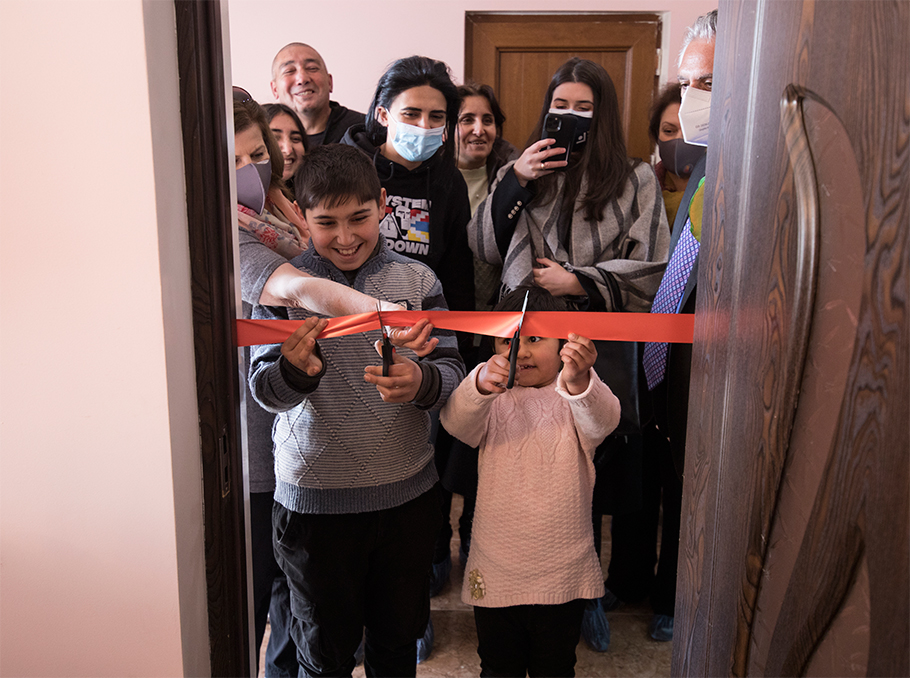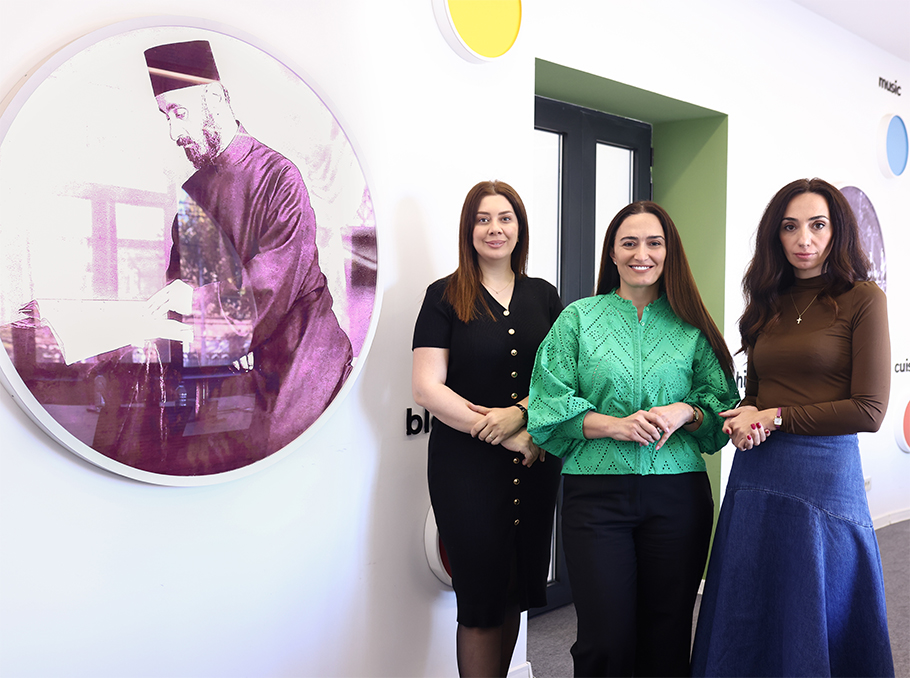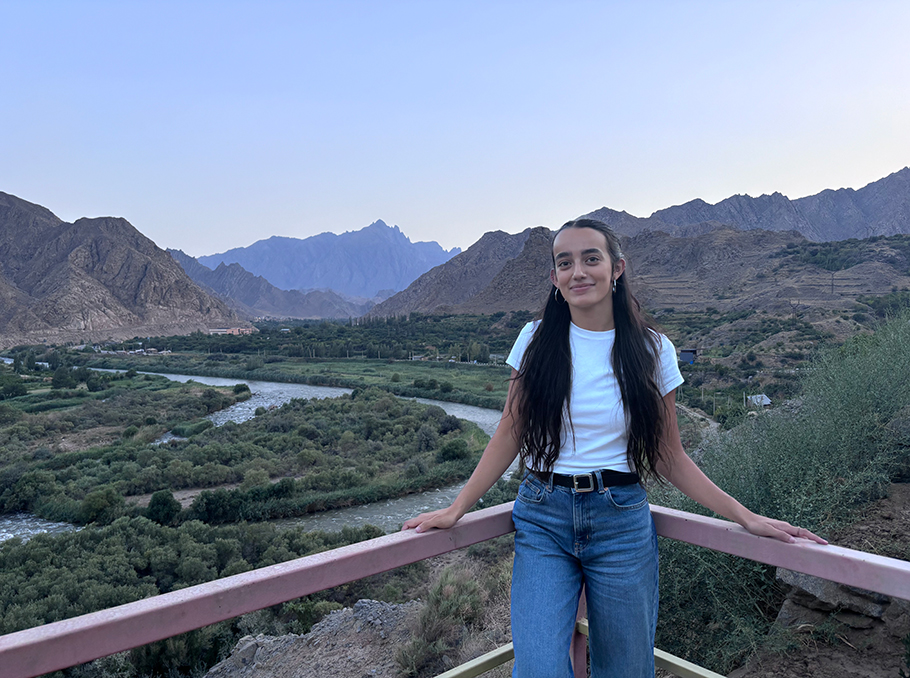The Yesayans are one of the last families to leave Yeritsvank community of Kashatagh.
“We never lost hope and were waiting for things to get back to normal. They were constantly urging us to leave the village, but my husband would get angry and argue with those who were leaving. ‘You have all run away, I won’t let my children go, we will stay,’ he would tell them,” says Lusine Bulghadaryan.
 Lusine Bulghadaryan with her child
Lusine Bulghadaryan with her child
One late evening, when the enemy was barely 20 kilometers away from the village and it was impossible to ignore the danger any longer, Lusine and her 5 children moved to Davit Bek village of Kapan, then to Tavush, where her husband was born. Documents, photos and a TV – these are the only things they brought from Artsakh.
 Lusine Bulghadaryan
Lusine Bulghadaryan Photo: Mediamax
“We were engaged in farming and cattle breeding. We had a peach orchard. It was a paradise, especially during the blossoming season. We brought nothing with us. There were elderly people back in the village. My husband helped everyone, took them out of the village, and he didn’t have time to take our belongings. He just opened the door of the barn to let the cattle out into the pastures so that they would not die.”

Photo: Mediamax
Soon, the Yesayan family will engage in farming and cattle breeding again in Nerkin Karmiraghbyur. It is far from their home, but reminds them of their village.
“We have a tree here in our yard. Every time I see it, it reminds me of my home. When we pass by, it always catches our eye and it seems we are still back home. The children even see our village in their dreams,” says Arkady Yesayan.
 Arkady Yesayan
Arkady YesayanPhoto: Mediamax
The Yesayan family is trying to start a new life in the village of Nerkin Karmiraghbyur, all the while cherishing memories of Artsakh. They were the first to have received a house and moved to Tavush through a program of the Armenian Resettlement Coalition (ARC).
After the war, the “Paros” Foundation, “Sahman” NGO, Teach For Armenia and “Focus on Children Now” decided to form a coalition and address the issues of people of Artsakh who are seeking permanent residency in Armenia. Realizing that the families who have temporarily taken refuge somewhere will eventually leave Armenia, these organizations from the Diaspora and Armenia quickly got down to work.

Photo: Mediamax
The resettlement program kicked off from Nerkin Karmiraghbyur village.
“We do serious work to get to know the families. We learn about them, visit them, sometimes they find us. We talk, try to learn and understand what they have brought with them, what they have lost, what plans they have got. Now Artsakh is doing a huge job trying to return the families. It is the most important thing to return to the part of Artsakh that belongs to us. We are trying to find families that have little or no chance of returning. We want to resettle them as soon as possible, so that after having overcome so many difficulties they can finally settle here, live and enjoy themselves,” says Peter Abajyan, Executive Director of “Paros” Foundation.
 Peter Abajyan
Peter AbajyanPhoto: Mediamax
Each of the organizations has its responsibilities within the resettlement program. The “Paros” Foundation is financially responsible for purchasing homes and renovations, “Sahman” NGO provides financial support to families. They assess the skills of families, their experience, and together they decide what to do, and provide relevant equipment and materials.
 Anahit Nazaryan
Anahit NazaryanPhoto: Mediamax
“This family will engage in poultry farming. We will provide them an incubator and build a small bird barn. We will also establish a greenhouse. Diversification is very important for us, so that the family doesn’t depend on one source of income: if one venture fails due to the season or other reasons, they will have various sources of income,” says Anahit Nazaryan, co-founder of “Sahman” NGO.

Photo: Mediamax
They are going to work with families for at least a year, provide consultations, help find a consumer market.
The Yesaysns discuss their plans with guests during the housewarming, the children show their corner of the house. It’s still a little foreign, but it’s theirs.

Photo: Mediamax
“We have furnished the house, consulting every detail with them. But they are seeing the house fully furnished for the first time. We even took a family photo, framed it and put it in the room so that they feel that it is their home. We want these families to stay in Armenia if they cannot return to Artsakh,” says Karine Abulyan, co-founder of “Focus on Children Now”.
 Karine Abulyan
Karine AbulyanPhoto: Mediamax
The Yesayans’ children have changed 4 schools since September. They never deprived their children of a chance to get education, no matter where they found refuge.
After the war, Teach For Armenia launched an “Emergency Education” initiative. TFA Teacher-Leaders participating in the program are still working with children from Artsakh settled in different regions of Armenia.

Photo: Mediamax
“During the pandemic and the war, we realized that there are things that force children to stay out of school. We’ve launched fundraising, which is still ongoing, bought tablets and provided them to the children. With the help of these tablets and online content, we were able to keep the children who had lost their homes, parents and relatives in the educational process. It gave them a sense of stability, which is very important for the child’s psychology. Children who have moved to Nerkin Karmiraghbyur will also be involved in our “Emergency Education”. We will provide them computer tablets and internet connection. But this is only the beginning of the road. Together with the members of the Armenian Resettlement Coalition, we can provide comprehensive support to the families,” says Larisa Hovhannisyan, Founder and CEO at Teach For Armenia.
 Larisa Hovhannisyan
Larisa Hovhannisyan
Another 4-5 families from Artsakh will settle in Nerkin Karmiraghbyur. The budget for one family resettlement is approximately $36,500. After Nerkin Karmiraghbyur, the program will continue in other villages, providing the people of Artsakh with permanent housing and strengthening the border.

Photo: Mediamax
“This luxury is too much for me,” says Arkady Yesayan. He will provide for his family, even a little better than before. But he does not hide the fact that he will leave everything in a heartbeat and return to his village if the opportunity arises.
“I wish this never happened and we were in our hut. If they give it back to us, I will leave this house tomorrow and go back, even if there are only ruins left.”
Lusine Gharibyan
Photos by Emin Aristakesyan





























Comments
Dear visitors, You can place your opinion on the material using your Facebook account. Please, be polite and follow our simple rules: you are not allowed to make off - topic comments, place advertisements, use abusive and filthy language. The editorial staff reserves the right to moderate and delete comments in case of breach of the rules.